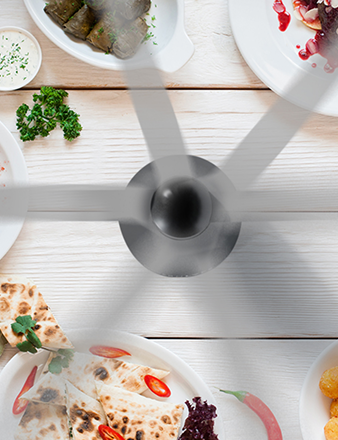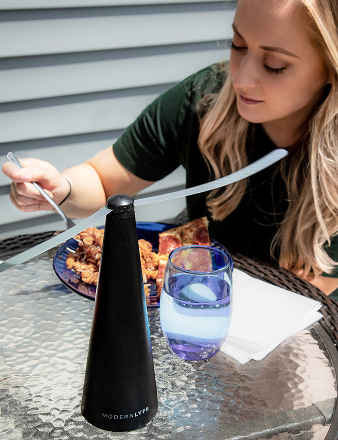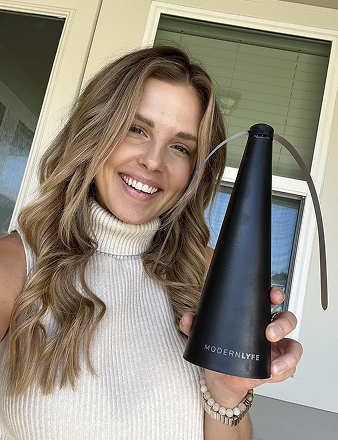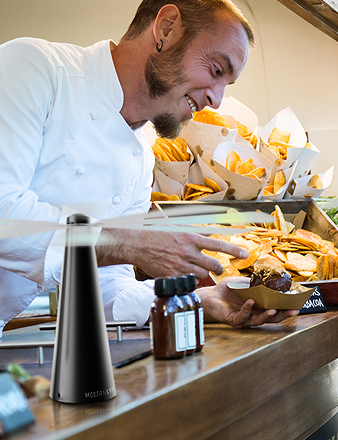A stuffy outdoor event or a warm hotel room can be instantly improved with a cooling breeze. That's the power of a well-placed 10 inch fan. It’s the smart cooling solution for hospitality, event planning, and any home.
What is a 10 Inch Fan?
Forget bulky pedestal fans or noisy box fans. The 10 inch fan offers the perfect balance: compact enough to be discreet, yet powerful enough to make a difference.
Its small footprint is a major advantage where space is limited. This fan isn't about blasting an entire room; it's about delivering targeted comfort exactly where it's needed, without getting in the way.
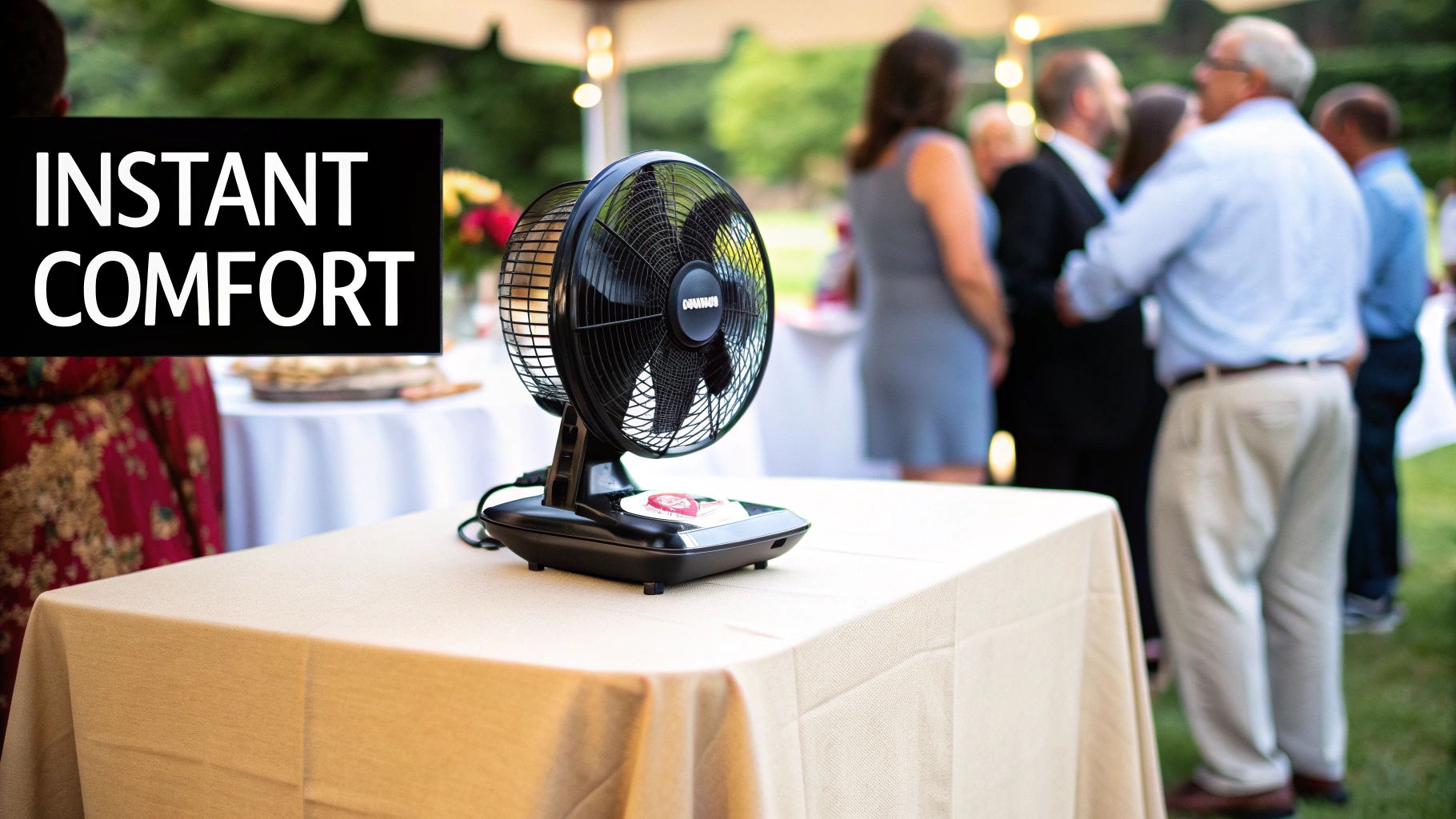
Why This Size Excels in Hospitality and Events
In hospitality, small details elevate the guest experience. A quiet, subtle breeze is one of those game-changing details.
A 10 inch fan is ideal for:
- Buffet Tables: Placed along a buffet line, these fans circulate air, providing a pleasant breeze for guests and keeping food areas fresh.
- Outdoor Receptions: Cool individual tables or seating areas without creating a wind tunnel that disrupts napkins or candles. It’s all about localized comfort.
- Guest Rooms: It's the perfect personal cooling option, quieter and more direct than central AC, giving guests control over their immediate environment.
These versatile fans are a key part of the global household fan industry, valued at around $32.29 billion in 2024. Their blend of affordability and effectiveness makes them a staple for businesses and homes.
The Power of Portability
Portability is what sets many 10 inch fans apart. Battery-operated models free you from the constraints of wall outlets, allowing you to bring comfort to previously hard-to-cool locations.
Think of a garden party, a pop-up vendor stall, or a remote patio corner. This cord-free freedom is a huge advantage. Additionally, the steady airflow is a great chemical-free method for deterring insects. Find more tips in our guide on using outdoor fans to keep bugs away.
The true value of a 10 inch fan lies in its ability to deliver effective, personal cooling right where you need it.
10 Inch Fan At a Glance
Here’s a quick overview of what makes the 10 inch fan so versatile.
| Attribute | Typical Specification | Primary Benefit |
|---|---|---|
| Size | 10-inch blade diameter | Compact for tables, powerful for personal cooling. |
| Airflow | 200-500 CFM | Provides focused, gentle circulation without disruption. |
| Portability | Often battery-powered | Usable anywhere, independent of power outlets. |
| Noise Level | 30-50 dB | Quiet operation won't disturb conversations or sleep. |
| Placement | Tabletop, floor, or mountable | Highly flexible for various settings. |
This combination of features makes it a top choice for creating a comfortable atmosphere in any space.
Decoding Fan Specs: What Really Matters
https://www.youtube.com/embed/Mdx9U-KW038
Shopping for a 10-inch fan can be confusing with terms like CFM, RPM, and wattage. Understanding these specs is the key to choosing a fan that cools effectively without driving up your energy bill.
Airflow is Everything: CFM vs. RPM
The most important metric is CFM (Cubic Feet per Minute), which measures the volume of air the fan moves. A higher CFM rating means a stronger, more effective breeze.
Don't fixate on RPM (Revolutions Per Minute). RPM only indicates blade speed, and faster isn't always better. An efficiently designed fan can move more air at a lower, quieter RPM. CFM is the true measure of a fan's power.
From Power Consumption to Motor Technology
Wattage (W) is another critical spec, indicating how much power the fan consumes. A lower wattage means lower electricity bills—a significant saving for businesses running multiple fans for extended periods.
The motor determines both power and efficiency. While traditional AC (Alternating Current) motors are common, the modern standard is the Brushless DC (BLDC) motor.
A Brushless DC (BLDC) motor is like a modern hybrid engine. It uses advanced electronics to run more efficiently, generate less heat, and operate far more quietly, delivering better performance with less wasted energy.
These modern motors can be up to 50% more energy-efficient than older AC counterparts. In 2024, fans with BLDC motors accounted for nearly 15% of household fan sales in the Asia-Pacific region, signaling a clear trend toward energy-saving technology. You can discover more insights about the history of fans on Wikipedia if you're curious.
What This Means for Your Choice
Understanding these specs helps you see past marketing hype. Prioritize CFM for cooling power, then consider wattage and motor type for long-term efficiency. This knowledge will help you select a 10-inch fan that perfectly fits your needs—for a patio, a wedding, or a bedside table—without overpaying or getting stuck with an inefficient model.
Choosing the Right Fan for Your Space
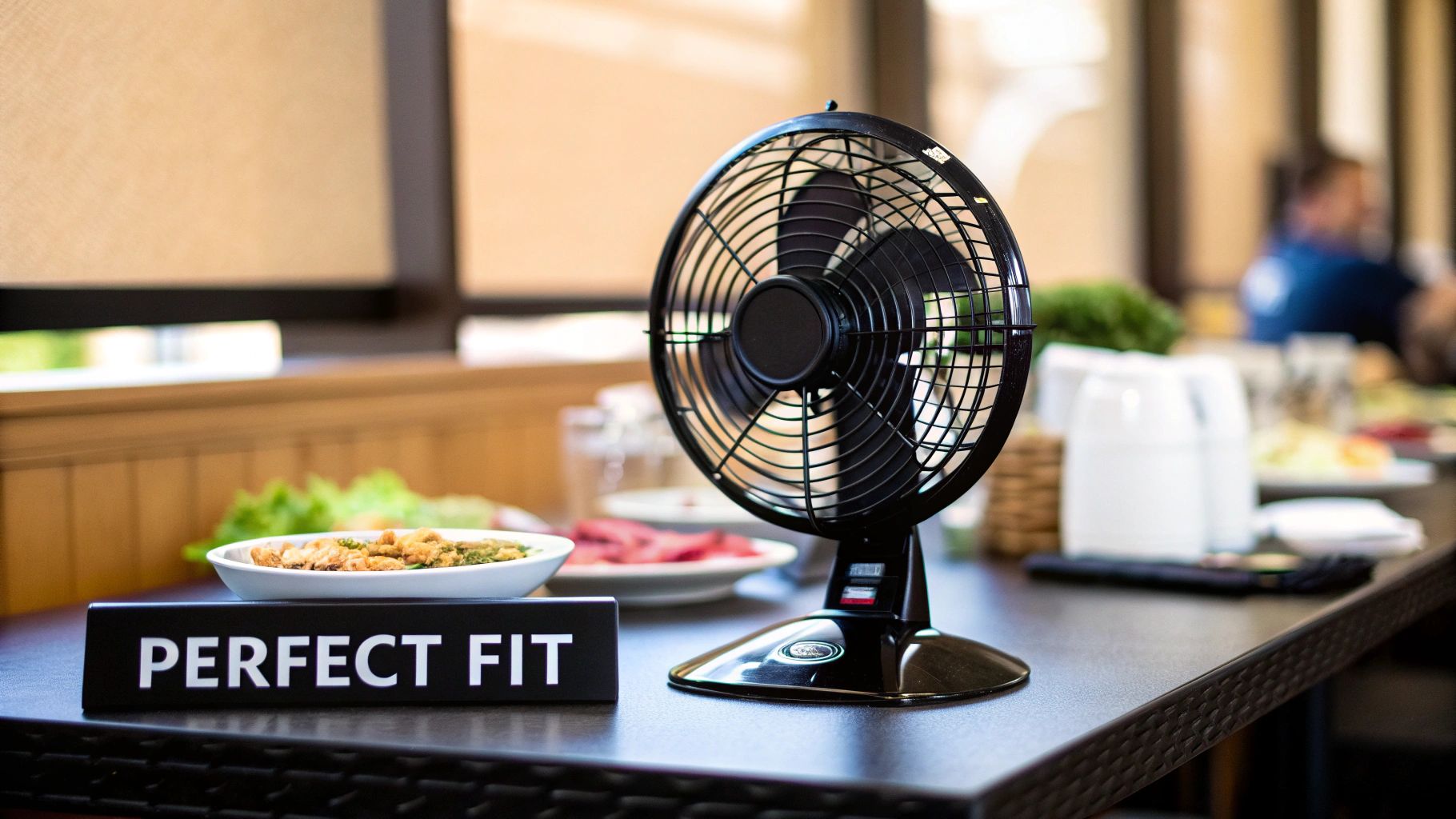
Knowing where a 10 inch fan can solve a problem is key. This fan isn't just equipment; it's a targeted solution for specific comfort challenges. Its blend of modest size and effective power is perfect for situations where larger fans are overkill and smaller ones are insufficient.
The secret is its discreet functionality. A 10 inch fan is strong enough to create a welcome breeze but compact enough to blend in, which is why it’s a go-to choice where ambiance matters as much as comfort.
Ideal Applications in Hospitality and Events
In a professional setting, the goal is to provide comfort without disruption. The 10 inch fan excels at this, tackling common issues with quiet efficiency.
Consider these scenarios:
- Guest Registration Desks: A stuffy check-in line creates stress. A small fan offers a personal breeze for guests and staff, setting a comfortable tone from arrival.
- Buffet and Catering Stations: Placed along a food line, fans cool guests and circulate air, which helps deter insects and keeps the area feeling fresh.
- Individual Table Cooling: For outdoor dining, a single 10 inch fan provides focused comfort without the "wind tunnel" effect of larger fans that can blow out candles or send napkins flying. For more ideas, explore our guide to the best outdoor table fans.
Bringing Versatile Cooling into Your Home
The problem-solving ability of a 10 inch fan extends perfectly to home use, fixing airflow issues in specific areas where central AC falls short.
The 10-inch fan acts like a spotlight for cool air. Instead of trying to flood an entire room, you can direct a focused beam of comfort exactly where it's needed—on a workspace, a reading nook, or a guest.
A quiet desk fan can transform a stuffy home office, making it easier to focus. In a hot kitchen, it provides a needed breeze without disturbing a gas flame. Its compact size is also ideal for bedrooms, offering gentle airflow for better sleep without the cost of running air conditioning all night.
Mastering Placement for Maximum Airflow
Getting the most from your 10-inch fan is more about placement than speed settings. Strategic placement turns a simple fan into an effective air circulation tool, creating a truly comfortable space.
The key is to work with natural airflow, not against it. By positioning your fan thoughtfully, you can generate powerful cooling currents that refresh an entire area.
Creating a Cooling Cross Breeze
One of the most effective techniques is creating a cross breeze. This involves using your 10-inch fan to either pull cool air in or push stale air out.
Here’s how:
- To Pull Cool Air In: On a cool evening, place your fan in an open window facing inward. This actively draws crisp outdoor air into the room.
- To Push Hot Air Out: During a hot day, reverse the position. Place the fan in a window facing outward to expel trapped hot air, which helps pull cooler air from other areas of the building.
This simple directional change makes a huge impact. You're no longer just circulating warm air; you're actively replacing it with cooler, fresher air.
Strategic Placement in Larger Spaces
For larger areas like event halls or patios, a single fan isn't enough. The solution isn't one giant fan but multiple smaller fans, like the 10-inch model, working together. This creates a gentle, consistent airflow that cools the entire area without creating disruptive drafts.
Think of it like a sound system. Instead of one massive speaker, you place several smaller speakers around the room for even sound. Multiple small fans do the same for airflow, ensuring every guest feels a comfortable breeze.
This multi-fan strategy eliminates hot spots and keeps the atmosphere pleasant for everyone.
Safety First Placement Pointers
Effective placement must also be safe, especially in busy environments. A poorly placed fan can quickly become a hazard.
Keep these safety rules in mind:
- Stable Surfaces: Always place fans on a flat, sturdy surface where they won't be easily tipped over.
- Secure Cords: In high-traffic areas, tape down power cords or run them along a wall to prevent tripping hazards.
- Clearance is Key: Ensure ample space around the fan for airflow and keep flammable items like tablecloths or curtains away from the blades.
Getting Power and Noise Levels Just Right
Beyond airflow, two other critical factors are the power source and noise level. Getting these wrong can turn a helpful tool into a major annoyance, especially when trying to maintain a specific atmosphere.
The power source dictates the fan's mobility. Corded models are reliable for fixed locations like a host stand or buffet table with a nearby outlet. But for outdoor patios or center tables at an event, cords are impractical.
For true flexibility, battery-operated fans are unmatched. They are perfect for outdoor events and complex layouts where outlets are scarce. If you're considering this option, our guide on battery-operated table fans is a great resource. USB-powered fans offer another solution, ideal for personal cooling at a desk or POS station with a computer or power bank.
How Loud Is Too Loud? Understanding Decibels
After choosing a power source, consider sound. Fan noise is measured in decibels (dB)—a lower number means a quieter fan. This is crucial for environments where people need to converse and relax without shouting over a motor.
A fan's decibel rating indicates its level of intrusion. In hospitality, the goal is comfort, not distraction. A quiet fan is a silent partner in creating a great guest experience.
For context, a whisper is about 30 dB, and a normal conversation is around 60 dB. A quality 10-inch fan should operate in the 30-50 dB range. On its lowest setting, it should be barely noticeable, like the quiet hum of a library.
This chart helps you decide if your goal is direct cooling or general air circulation.

Ultimately, your choice between direct cooling and air circulation will guide you to the right fan and placement strategy.
Finding the Sweet Spot Between Power and Peace
The ideal 10-inch fan delivers the performance you need without disrupting the environment. This table breaks down which power source is best for various situations.
Power Source vs. Use Case Comparison
| Power Source | Best For | Pros | Cons |
|---|---|---|---|
| Corded (AC) | Fixed indoor spots (desks, counters, buffets) | Consistent, powerful airflow; no need to recharge. | Limited by outlet proximity; cord can be a trip hazard. |
| Battery-Operated | Outdoor events, patio tables, weddings, mobile setups | Unbeatable portability; clean, cord-free look. | Limited runtime; requires recharging or battery replacement. |
| USB-Powered | Personal workspaces, cashier stations, small tech areas | Highly convenient; can be powered by laptops or power banks. | Generally less powerful than corded or battery models. |
By matching the power type to your intended use and selecting a low-decibel model, you can find a solution that keeps everyone cool and comfortable without becoming a noisy distraction.
Simple Maintenance for Lasting Performance
Regular care ensures your 10 inch fan performs at its best and lasts longer. Over time, dust and grime accumulate on the blades and grille, which reduces airflow and can pose a safety risk.
A clean fan is an effective fan. A few minutes of maintenance each month will keep it running efficiently and ensure the air it circulates is fresh and clean.
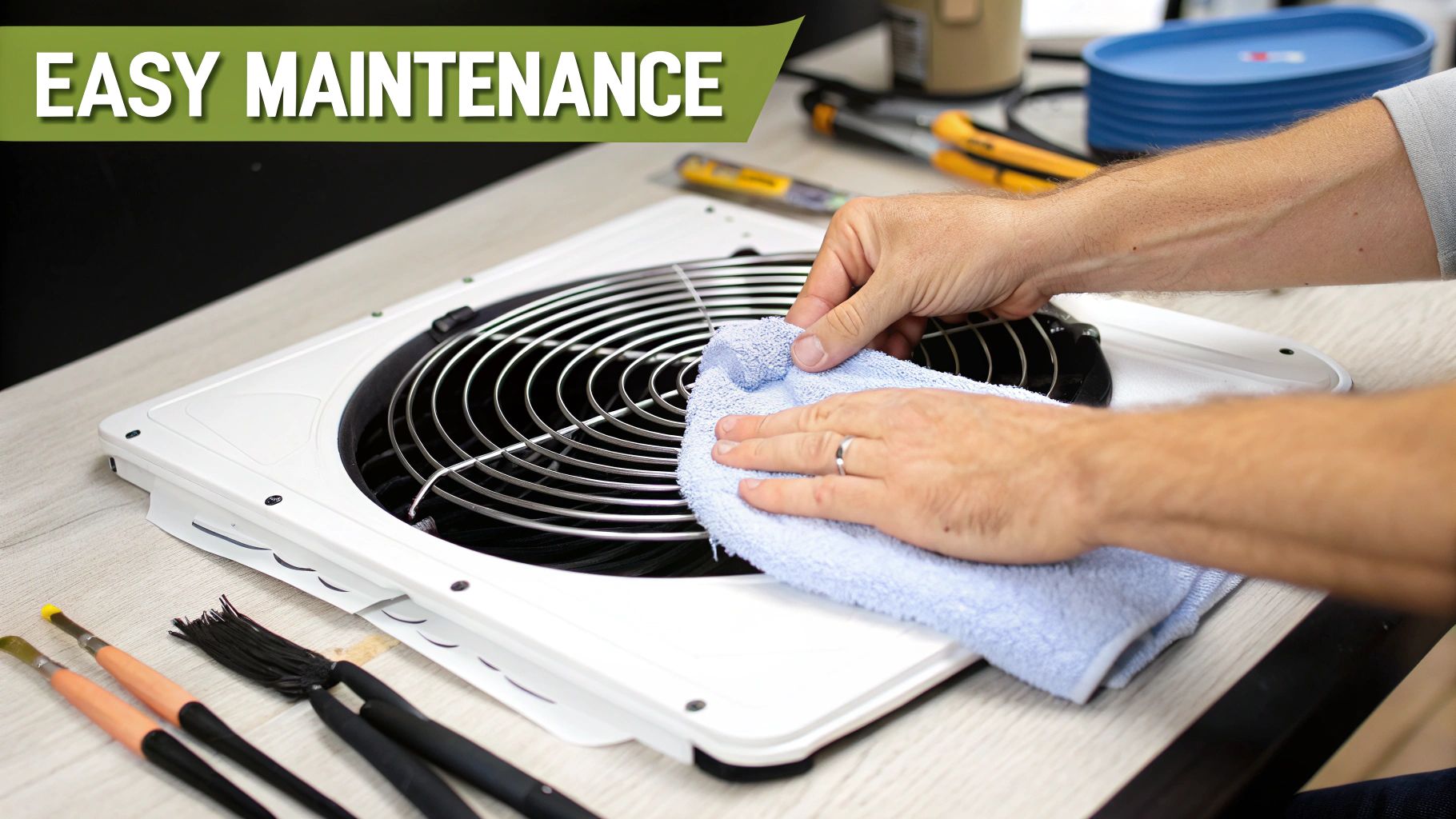
A Quick Cleaning Guide
Keeping your fan in top shape is simple. First and foremost, always unplug the fan or remove the batteries before cleaning.
-
Wipe Down the Exterior: Use a soft, damp cloth to wipe the fan's housing and base. Avoid harsh chemical cleaners that can damage the finish.
-
Clean the Grille: Use a vacuum with a brush attachment for light dust. If the grille is removable, wash it with warm, soapy water and let it dry completely.
-
Address the Blades: Gently wipe each blade with a cloth. Removing dust buildup helps keep the fan balanced for quiet, wobble-free operation.
Regular cleaning is vital for consistent performance and applies to all air-moving devices, highlighting the importance of clean filters and components.
Troubleshooting Common Issues
Even well-maintained fans can experience issues. Fortunately, most common problems have simple fixes.
A rattling sound is often the first sign of a simple problem. Before assuming the worst, check for loose screws or an imbalanced blade. A few seconds of inspection can often solve the issue and prevent further wear.
If your fan develops unusual noises or seems less powerful, check these common causes:
- Rattling Sounds: Tighten any visible screws on the grille or base. Ensure the fan is on a flat, stable surface.
- Reduced Airflow: This is typically caused by dusty blades. A thorough cleaning will usually restore full power.
- Fan Won't Start: Check the basics. Is it plugged in securely? Are the batteries charged? For USB models, try a different port or power source.
Your Questions About 10-Inch Fans, Answered
Here are answers to the most common questions to help you choose with confidence.
Can a 10-inch fan really cool a whole room?
A 10-inch fan excels at personal cooling, not whole-room climate control. It’s perfect for creating a comfortable microclimate at a dining table, desk, or small lounge area.
To improve air circulation in a larger room, use multiple fans or position one strategically to create a cross-breeze.
To circulate air room-wide, use a 10-inch fan to pull cool air in from an open window or push stale, hot air out. The goal is a gentle, consistent air exchange rather than a direct blast.
How long does a battery-powered 10-inch fan actually last?
Runtime depends on the model's quality and the speed setting. A quality battery-operated 10-inch fan typically lasts between 4 to 12 hours on a full charge.
Running the fan on its lowest setting will maximize battery life, making it suitable for all-day events.
Does having more fan blades mean it's better?
Not necessarily. More blades (e.g., five) can result in quieter operation, while fewer blades (e.g., three) can sometimes move air more efficiently.
The most important factors are the aerodynamic design of the blades and the power of the motor. Blade count is only one part of the overall performance equation.
Ready to create a more comfortable, welcoming space? The right fan can transform an environment. Explore the premium, quiet, and effective cooling solutions from MODERN LYFE to find your perfect match.

